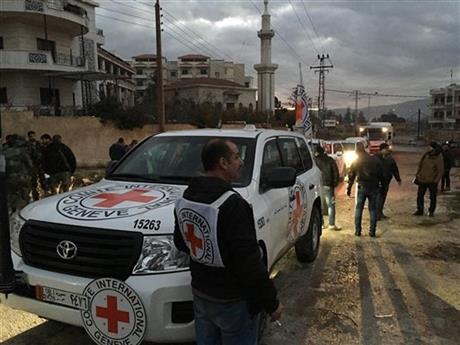Breaking
Aid convoys reach 3 Syria communities besieged for months

A convoy carrying food, medical supplies and other items. Photo courtesy of the The International Committee of the Red Cross (ICRC), the Syrian Arab Red Crescent (SARC) and the United Nations (UN).
DAMASCUS, Syria – The U.N. humanitarian chief has called for Monday’s delivery of aid to three besieged towns in Syria to be the first of many and welcomed a Syrian statement that such deliveries should be repeated and sustained.
Stephen O’Brien told reporters after briefing the U.N. Security Council behind closed doors that the arrival of convoys to help civilians in the three towns cut off for months by the war in Syria must not be “either one-off or exceptional.”
The U.N. says 4.5 million Syrians are living in besieged or hard-to-reach areas and desperately need humanitarian aid, with civilians prevented from leaving and aid workers blocked from bringing in food, medicine, fuel and other supplies.
Reports of starvation and images of emaciated children have raised global concerns and underscored the urgency for new peace talks that the U.N. is hoping to host in Geneva on Jan. 25.
Aid convoys with food and other supplies reached three besieged villages on Monday – Madaya, near Damascus, where O’Brien said about 400 people need to be evacuated immediately to receive life-saving treatment for medical conditions, malnourishment and starvation, and the Shiite villages of Foua and Kfarya in northern Syria.
O’Brien said efforts will be made to get ambulances to Madaya on Tuesday to evacuate the 400 people, of all ages, if safe passage can be assured.
It will take several days to distribute the aid in Madaya, near Damascus, and the Shiite villages of Foua and Kfarya in northern Syria, and the supplies are probably enough to last for a month, aid agencies said.
“It’s really heartbreaking to see the situation of the people,” said Red Cross spokesman Pawel Krzysiek, who oversaw the distribution in Madaya. “A while ago, I was just approached by a little girl and her first question was, ‘Did you bring food?’”
Sajjad Malik, a representative of the U.N. High Commissioner for Refugees who took part in the operation described how grateful the people were. “It’s cold and raining, but there is excitement because we are here with some food and blankets,” Malik said.
The operation marked a small, positive development in a bitter conflict now in its fifth year that has killed a quarter of a million people, displaced millions of others and left the country in ruins.
Rebels opposed to President Bashar Assad are in control of Madaya, a mountain town about 15 miles (24 kilometers) northwest of Damascus. Government troops and fighters from the Lebanese militant group Hezbollah have surrounded the town. Opposition activists and aid groups have reported several deaths from starvation in recent weeks.
Syria’s U.N. Ambassador Bashar Ja’afari denied anyone was starving in Madaya and blamed Arab television especially “for fabricating these allegations and lies.”
Speaking at U.N. headquarters, he blamed “armed terrorist groups” for stealing humanitarian aid and reselling it at prohibitive prices.
“The Syrian government is not and will not exert any policy of starvation against its own people,” Ja’afari said.
But O’Brien, the U.N. humanitarian chief, said all the evidence the U.N. has shows there has been very severe malnourishment, severe food shortages, and reports of people “who are either starving or indeed have starved and died.”
An Associated Press crew saw the first three trucks cross into Madaya on Monday, although journalists were not allowed to accompany the aid workers. At the town’s entrance, several civilians – including five children shivering against the cold – said they were waiting to be taken out.
“I want out. There is nothing in Madaya, no water, no electricity, no fuel and no food,” said Safiya Ghosn, a teacher who stood at the entrance of the town hoping to be evacuated.
Simultaneously, trucks began entering Foua and Kfarya, which are both under siege by rebel groups hundreds of miles (kilometers) to the north.
Tales of hunger and hardship have emerged from those inside all three communities: Pro-government fighters recently evacuated from inside Foua and Kfarya have said some residents are eating grass to survive. Residents of Madaya similarly have reported living off soup made of leaves and salt water.
Madaya has attracted particular attention in recent days because of reports of deaths and images in social media of severely malnourished residents. The aid operation, which is being facilitated by the U.N., was agreed on last week.
Some Assad supporters have said the photos were faked, and others alleged the rebels were withholding food from residents.
The aid group Doctors Without Borders says 23 people have died of starvation at a health center it supports in Madaya since Dec. 1, including six infants and five adults over 60.
Krzysiek, the Red Cross spokesman, said in a statement that he saw a lot of people on the street, “some of them smiling to us and waving to us, but many just simply too weak.”
Almost 42,000 people in the town are at risk from hunger, said Yacoub El Hillo, the U.N.’s Resident and Humanitarian Coordinator in Syria.
O’Brien said trucks were being unloaded Monday night by flashlight and the light from iPhones.
Hezbollah’s Al-Manar TV channel showed a group of people, including women and children, waiting for the convoys at Madaya’s main entrance. In interviews, they accused rebel fighters inside of hoarding humanitarian assistance that entered the town in October and selling the supplies to residents at exorbitant prices.
___
Lederer reported from the United Nations.





















